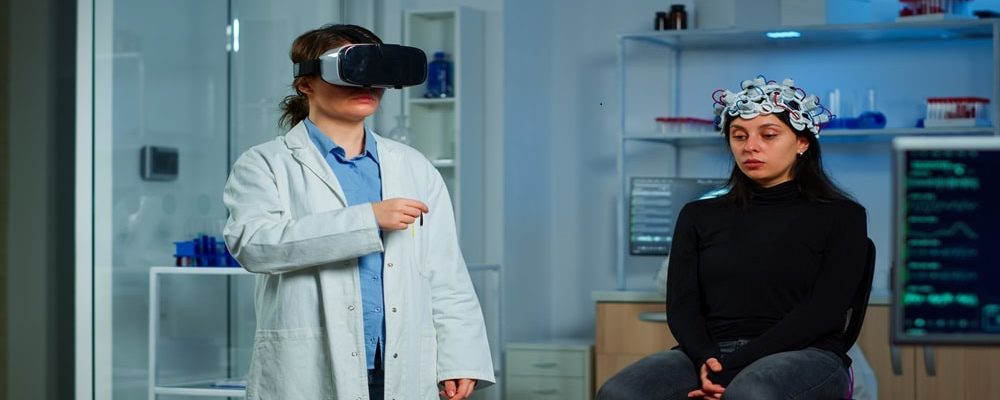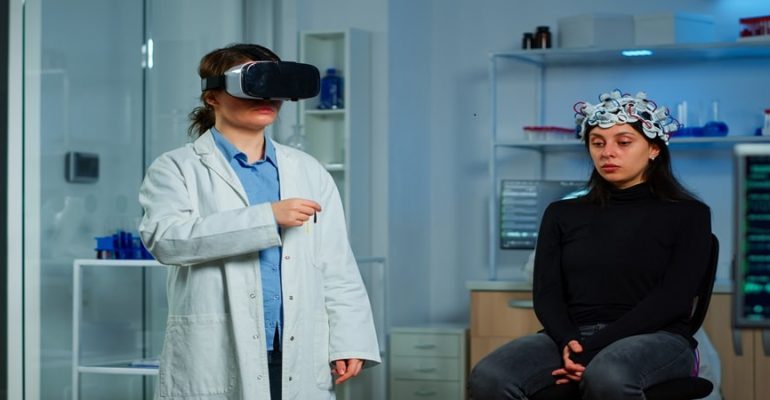
XR in Phobia Treatment: Use Cases & Trends

XR in Phobia Treatment: Use Cases & Trends
Extended Reality (XR) can be a powerful tool for mitigating phobias by creating immersive environments that allow individuals to confront their fears in controlled, safe, and progressive ways.
The Role of XR in Phobia Treatment
Phobias are often deep-rooted fears, including claustrophobia (fear of enclosed spaces), acrophobia (fear of heights), and agoraphobia (fear of open spaces). Traditionally, therapies such as Cognitive Behavioral Therapy (CBT) and exposure therapy have been used to address these fears. However, XR technologies enhance these approaches by providing a safe yet realistic space for gradual exposure, helping individuals build resilience and confidence in a controlled manner.
Here’s how XR plays a role in treating phobias:
1. Gradual Desensitization
XR allows for customizable and scalable experiences, meaning that therapists can control the intensity and duration of the exposure. As the individual progresses, the difficulty of the virtual scenario can be increased, offering a personalized approach to therapy. For example:
- The height in a virtual skyscraper can be gradually increased for someone with acrophobia.
- Social anxiety patients can start by interacting with one or two virtual characters before moving to larger groups.
2. Controlled Environment for Safe Learning
One key challenge in traditional exposure therapy is the unpredictability of real-world scenarios. With XR, the environment is completely under the control of therapists, allowing them to pause, adjust, or repeat exposures as necessary. Patients can take their time and explore their fears at their own pace, reducing the risk of overwhelming or traumatizing experiences.
3. Immersion and Realism
The immersive nature of XR, particularly through Virtual Reality (VR), creates a sense of “presence,” making the experience feel real enough for the patient to react naturally but still know they are in a safe space. This is crucial for people with phobias, as the level of realism encourages the brain to process the experience as if it’s happening in the real world, helping to reduce the irrational fear over time.
4. Reducing Avoidance Behavior
Many people with phobias tend to avoid their fears completely, making it difficult to overcome them. XR offers a non-threatening way to face fears, thus reducing avoidance. Over time, patients can experience less anxiety in real-world situations after engaging with XR therapy.
5. Cognitive Behavioral Therapy (CBT) Integration
XR can be used in conjunction with CBT to address the thoughts and emotions associated with the phobia. For instance, a patient with a fear of spiders (arachnophobia) can use a VR simulation to gradually confront spiders while simultaneously working with a therapist to manage negative thoughts and physical reactions.
6. Data and Progress Tracking
XR systems can track patients’ reactions, such as heart rate, body movements, and engagement levels during exposure therapy. This data allows therapists to monitor progress and adjust the treatment plan in real-time, making therapy more effective.
7. Customizable and Scalable
XR technology offers the flexibility to create customized environments based on specific phobias. Whether it’s a fear of driving, animals, or confined spaces (claustrophobia), XR can be tailored to mimic almost any scenario, offering scalable solutions across various fear-inducing situations.
Use Cases of XR in Phobia Mitigation
1. Fear of Heights (Acrophobia) Virtual Reality is often used to help individuals with acrophobia face their fear of heights. For example, VR simulations create towering skyscrapers or cliffs where the user is gradually exposed to varying heights, from a low balcony to the top of a building. Controlled repetition and exposure allow patients to get accustomed to the sensations and anxieties of height in a non-threatening way.
2. Fear of Flying (Aviophobia) XR-based flight simulators allow users to experience every aspect of flying—boarding a plane, turbulence, and takeoff—all from the safety of a virtual space. This controlled exposure helps individuals gradually reduce their anxiety around flying by interacting with common flight-related triggers.
3. Fear of Public Speaking (Glossophobia) AR and VR are being used to simulate public speaking environments, such as conferences or meetings, where individuals can practice speaking in front of a virtual audience. These simulations provide varying levels of complexity, such as hostile or receptive audiences, allowing users to build confidence progressively.
4. Fear of Enclosed Spaces (Claustrophobia) Using XR, individuals can be introduced to enclosed spaces gradually. For example, a VR headset might simulate being in an elevator or a small room, helping patients acclimate to tight environments. As their comfort grows, the system can simulate smaller, more challenging spaces.
5. Panic Disorder and Agoraphobia XR can be a powerful tool in helping people with agoraphobia (fear of open or crowded places) and panic disorders. Users can practice venturing into wide-open environments like parks or busy streets in an immersive experience, gradually overcoming anxiety associated with such spaces.
Latest Technologies and Trends in XR for Phobia Treatment
1. Haptic Feedback and Biofeedback Sensors Integrating haptic technology and biofeedback sensors is one of the latest trends in XR therapy. These tools monitor heart rate, skin temperature, and other stress indicators, providing therapists with valuable data on the user’s physiological state. This data helps customize treatments to the user’s specific needs, ensuring more precise therapy sessions.
2. AI Integration in XR Therapy Artificial Intelligence (AI) is increasingly used to personalize phobia treatment in XR. AI algorithms analyze user behavior and physiological responses to provide dynamic, adaptive therapy sessions. The system adjusts the exposure based on the user’s tolerance, enhancing the effectiveness of the treatment.
3. AR Therapy on Mobile Devices Mobile Augmented Reality (AR) applications make therapy more accessible. These apps allow users to practice confronting their phobias in everyday environments using their smartphones. For example, AR apps can overlay digital spiders in one’s living room for those with arachnophobia, creating a controlled yet familiar setting for exposure therapy.
4. XR in Group Therapy XR platforms are being developed to simulate group therapy settings, where individuals with similar phobias can confront their fears together in a shared virtual environment. This collaborative approach leverages social interaction to ease anxiety and encourage group support, enhancing the overall therapy experience.
Conclusion
Extended Reality is revolutionizing the way phobias are treated. By providing a safe, controlled environment for exposure therapy, XR offers significant advancements in treating anxiety-related disorders. As the technology continues to evolve, with AI integration, haptic feedback, and more accessible AR solutions, XR promises to be an essential tool for therapists and patients alike.